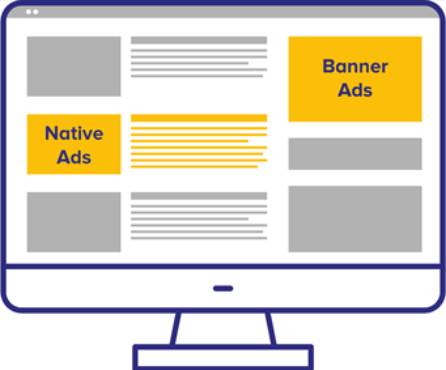Online advertising is now everywhere, users are more and more used to it and therefore less and less sensitive. The objective of a large number of marketing professionals is to innovate in order to capture the attention of Internet users and to increase their notoriety. Indeed, with classical advertising formats, the click rate would have gone from 10% to 1% between the years 2000 and 2014. Let’s see in this article how Native Advertising is used to hide the ad in order to enhance it to its audience.
Native Advertising: definition
Native Advertising also called Native Ads, native advertising or chameleon advertising is a form of digital advertising that aims to blend perfectly with the editorial content proposed around it. Native Advertising is a form of advertising less intrusive than those to which Internet users are accustomed and aims to maximize the number of readings / views of the ad. It is part of a brand content strategy and competes with banner ads.
The team within a company that will create the advertising campaigns will therefore be particularly sensitive to the context around the advertisement to ensure that it fits both in terms of content (text, tone used, type of information put forward…) and form (visuals, colors, size…). The transition between the content and the advertisement must be very fluid.
The advertiser pays particular attention to this aspect so that his site is as pleasant as possible.
Concerning the user experience, a Native Ads does not change anything to his navigation on the site since the advertising is adapted and is an integral part of the content, it does not interrupt the user.
The big digital companies have done everything possible to promote Native Ads so as not to hinder users in the use of their services and create a more harmonious whole. Social networks are particularly adapted for this type of advertising.
Whether it is for Facebook, LinkedIn or Instagram ads, brands have the possibility to make sponsored posts, so they are integrated in the news feed. Thus, brands have no choice but to create relevant content and for digital giants Facebook, LinkedIn and Instagram, they are guaranteed to bring a unique user experience with less intrusive stimuli.
Natives Ads can also be found on Google with sponsored links that appear at the top of the page. They look pretty much the same as links to other websites, but they just have an “ad” tag.
On Internet sites, Natives Ads are present when they are for example incorporated among a list of articles.
Native Ads: how to recognize them?
The principle of native Ads is precisely to make sure that they are not recognized. However, it is still possible for Internet users to spot them, because they have become very present in recent years and they are increasingly aware.
Most of the time, they are subtly announced, that is to say that it will be mentioned next to the advertisement, the link or the sponsored post one of the following terms: “ad”, “sponsored”, “recommended”, “Ads”…
Sometimes there is, according to some sites, a difference of colors between the classic contents and the sponsored contents, but generally this remains very light so as not to mar the harmony of the web page.
Native Advertising: what are its advantages?
The advantages of Native Advertising lie mainly in the fact that this form of advertising is the most respectful of the user experience compared to traditional advertising.
Thus, brands can create a higher engagement of Internet users since they are solicited on the right channels, at the right time and we make sure to address the right people.
The emphasis on relevant content and non-intrusive format is also a real advantage for Native Advertising. It requires a lot of work upstream to bring added value to the advertisement and to adapt it as well as possible to its target. In the long run, it also allows to create a stronger link with potential customers and to inform them rather than only push them to consume.
This more respectful type of advertising is particularly effective and is also widely preferred by Internet users who reject other forms of advertising that are too aggressive.
Native Ads VS Classic Banners

A comparison of the two advertising formats shows that there is a significant gap between the two methods in favor of Native Ads.
A study by IPG Media and Sharethrough found the following data:
- Consumers view Native Ads 52% more often than banner ads
- Natives Ads generate a 32% increase in brand popularity versus 23% for banner ads
- Natives Ads also have 18% higher purchase intent than traditional banners (i.e. 52% vs. 34% intent)
- Consumers are likely to share Native Ads with their friends or family for 32% of them versus 19% for traditional banners
- 71% of consumers personally identify with the brand of an ad when it is a Native Ads versus 50% for a banner ad
Thus, we can see that Native Ads are more engaging and allow to better increase the popularity of a brand. The return on investment of an advertising campaign of this type is more important.
According to an IFOP and Adyoulike survey:
The percentage of respondents who identified the formats presented as advertising content was 29% for Natives Ads versus 77% for classic banners. Natives Ads are indeed less visible.

Natives Ads: the critics of this strategy
This strategy has advantages and disadvantages and has received some criticism.
For the Internet users, this form of advertising is a way to avoid the classic advertisements with pop-ups of all kinds and redirections on certain sites which greatly disturb the navigation. However, the main criticism is that the advertisement is so well integrated into the content of the web page that the Internet user does not manage to perceive the true nature of the information and its advertising character.
The Internet user can feel duped by this practice and develop a negative emotion towards the company that is advertising.
On the side of the broadcasting platform, it is necessary to make sure that the advertising does not affect its own site. Indeed, it is possible that the Internet user will not return to the site if he discovers that there is too much advertising content that takes him away from his initial search.
In some types of contents like journalistic texts, Natives Ads can be badly perceived and make lose credit to the seriousness of the information given in the article and to the reputation of the newspaper.
Natives Advertising: example on Instagram
In this example we can see that the sponsored post on Instagram looks almost like a classic post, except for the circled elements. Thus, we realize that for the Internet user the sponsored post is as easy to read as any other content.

Natives Ads are becoming more and more popular in the digital world and are omnipresent on social networks. To set up an advertising campaign with Native Ads you need to be able to produce the right visuals with a message adapted to the defined target and the context of the ad.

